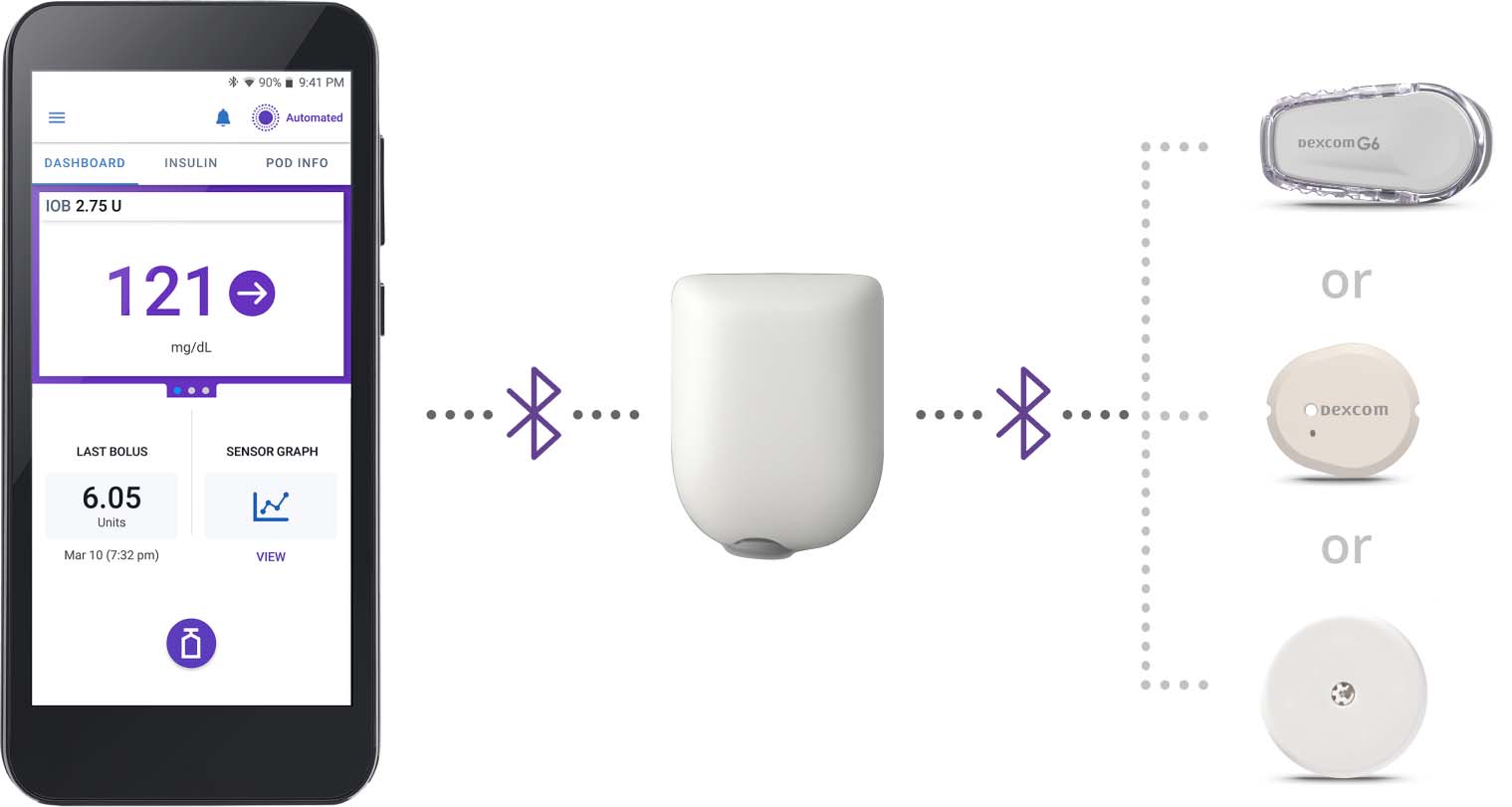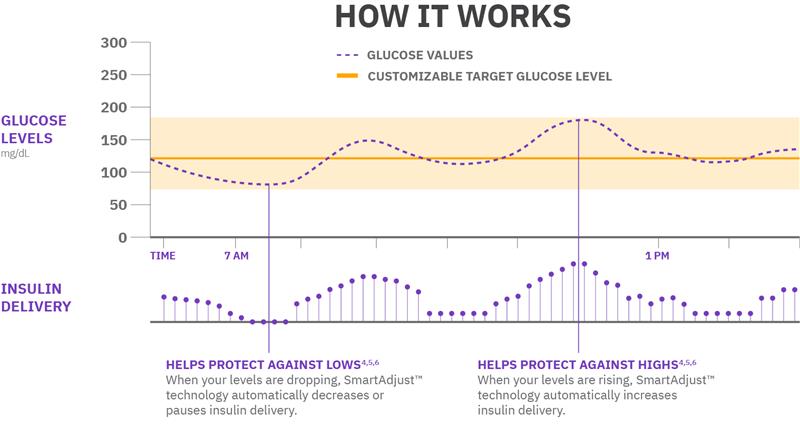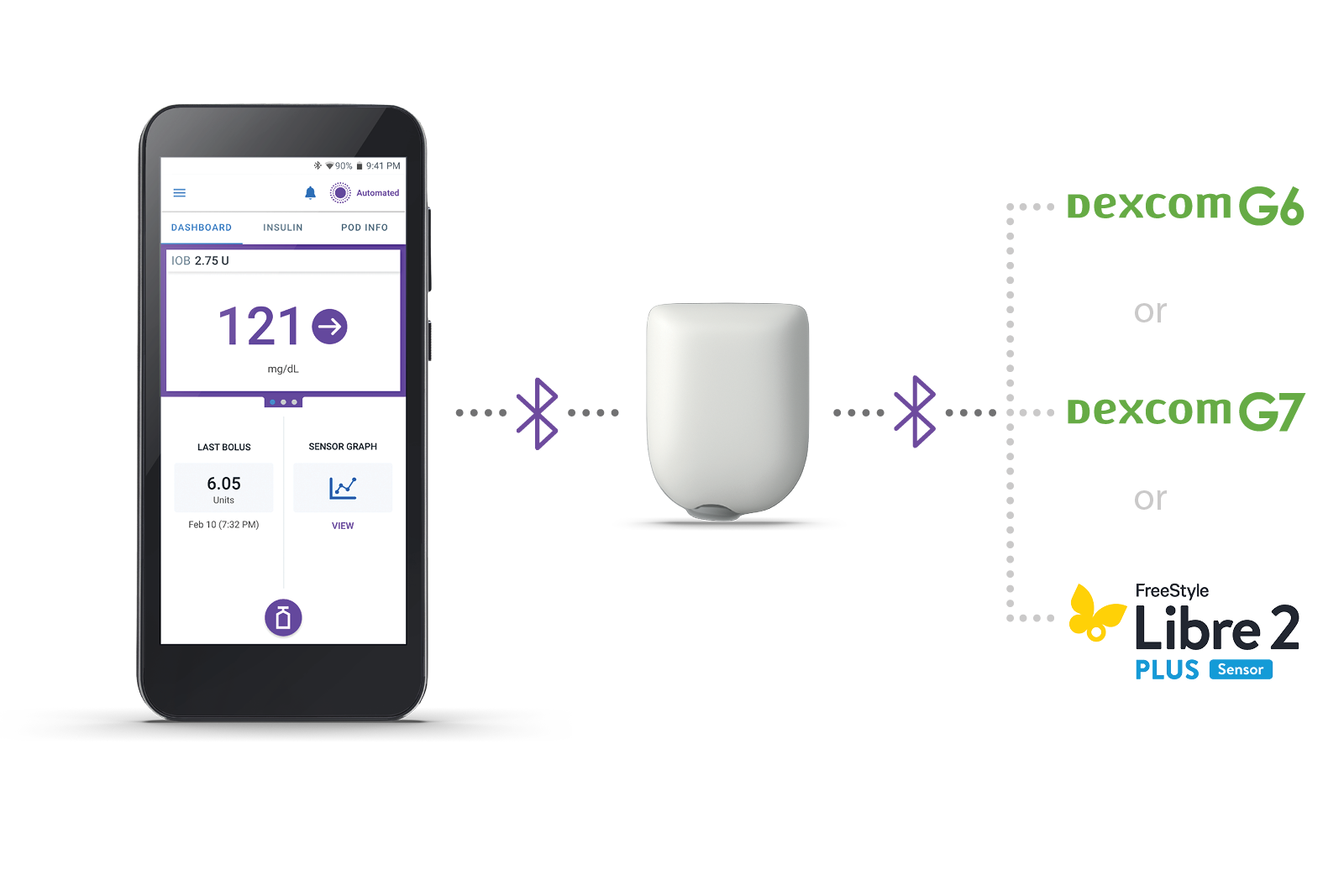Automated Insulin Delivery, Explained.
Automated Insulin Delivery (AID) is revolutionizing the way people manage their diabetes.
What is Automated Insulin Delivery?
According to the new 2025 ADA Standards of Care, Automated Insulin Delivery (AID) Systems are the preferred insulin delivery method to improve glycemic outcomes and reduce hypoglycemia in youth and adults with type 1 diabetes, and other types of insulin deficient diabetes.1
AID systems, also known as Hybrid Closed Loop (HCL) systems, use an insulin pump and a compatible continuous glucose monitor (CGM) or sensor that ‘communicate’ to automatically deliver insulin based on real-time glucose information.
AID uses smart software known as an algorithm to adjust basal insulin doses every few minutes, in small amounts, continuously readjusting how much insulin to deliver based on the predicted glucose and trend.
With this precise and personalized dosing, automated insulin delivery can improve glucose control and reduce A1c1, in addition to reducing some of the burden of diabetes management.
How does Automated Insulin Delivery work?1
An automated insulin delivery (AID) system is made up of three main parts:
- An insulin pump or Pod
- A compatible CGM/sensor
- Smart software, known as an algorithm
Click below to find out more about insulin pumps and CGM/glucose sensors or read on to learn how they work together with the algorithm in an AID system!
AID allows for communication between the Pod or Pump, the algorithm, and the CGM/sensor.
In simple terms, the sensor talks to the Pod or Pump, where the algorithm then decides to automatically increase, decrease or pause insulin delivery depending on whether glucose levels are stable, rising or falling.
Over time, the system can adapt to your body’s total daily insulin needs. While the systems adjust insulin, Hybrid Closed Loop (HCL) AID systems are not yet fully automatic - you still need to tell the system that you are going to eat and deliver additional insulin (meal bolus).


Over time, the system can adapt to your body’s total daily insulin needs. While the systems adjust insulin, Hybrid Closed Loop (HCL) AID systems are not yet fully automatic - you still need to tell the system that you are going to eat and deliver additional insulin (meal bolus).
Automated Insulin Delivery in practice
Generally, every 5 minutes:
- The glucose sensor reports your glucose levels to the Pod or pump.
- The algorithm within calculates whether insulin delivery needs to be increased, decreased, remain the same or stopped completely.
- The Pod or pump delivers the amount of insulin the algorithm decides on.
- The sensor picks up on any changes to your glucose level and reports that to the algorithm… and the circle continues. Which is the reason for the term ‘loop’.
How does this help people with diabetes?
AID systems are an exciting development in diabetes technology because the automated adjustments to insulin delivery can help to control blood glucose levels, reduce hypoglycemia (low blood sugars) and increase time in range.3
An AID system can help lessen the burden of managing your diabetes, as well as helping to reduce highs and lows throughout the day and night.4-6
There are several automated insulin delivery systems now available, so speak to your diabetes team about your options.
Omnipod® 5 Automated Insulin Delivery System
Say hello to tubeless automated insulin delivery with Omnipod 5
Omnipod 5 is the first and only tubeless AID system integrated with the leading sensor* brands, offering automated† insulin delivery with freedom from multiple daily injections, tubes AND fingersticks.§
Omnipod 5 is indicated for people living with type 1 diabetes ages 2+ and adults with type 2 diabetes ages 18+.
†Bolus for meals and corrections are still needed.
§Fingersticks required for diabetes treatment decisions if symptoms or expectations do not match readings.
Automated Insulin Delivery, Simplified.
You and your healthcare provider can choose your target glucose setting. There are five options between 110 mg/dL to 150 mg/dL.
Each Pod contains SmartAdjust™ Technology, the algorithm that adjusts insulin every 5 minutes using your customized target glucose or glucose target.
Each wearable, waterproof‡ Pod continuously delivers insulin for up to three days (72 hours).
Bolus doses and correction doses are given by using the Omnipod 5 App, either on the Insulet provided Controller or through a compatible smartphone.
The result? Omnipod 5 proactively helps to correct highs, protect from lows4-6, and has been shown to lower A1c2 so you can spend more time living life and less time thinking about diabetes.
Additional Features of the Omnipod 5 AID System
SmartBolus Calculator
Like all AID systems, Omnipod 5 still needs you to bolus for meals (additional insulin given for a meal). The SmartBolus Calculator can suggest a bolus amount of insulin based on your individual settings, entered values, and sensor glucose value and trend. Your healthcare provider may have given you instructions on how much to enter into the SmartBolus Calculator. Or may have instructed you to use custom food entries, like small, medium or large, rather than carb counting. The SmartBolus Calculator allows you to choose what works for you in terms of meal bolusing methods.
Activity feature
Enabling the Activity Feature will automatically increase the Target Glucose and reduce insulin delivery for times when you’re concerned about glucose levels going low. Many people use the Activity feature before, during or after exercise, but it can be used in any situation where you may want to deliver less insulin. Sleepovers, sick days, and even trips to the grocery store can all be great times to use the Activity feature!


Is the Omnipod 5 right for me?
Frequently Asked Questions about Automated Insulin Delivery System
What is the Omnipod 5 Automated Insulin Delivery System?
Is an AID system the same as a Hybrid Closed-Loop system?
What do I need to know to be prepared for Omnipod® 5?
If you are interested in the Omnipod 5 System, head over to our Get Started page to check your benefits.
Continue reading:
Related Articles
Other topics
References and Disclaimers
*A separate prescription is required for the glucose sensor.
†Bolus for meals and corrections are still needed.
§Fingersticks required for diabetes treatment decisions if symptoms or expectations do not match readings.
*Sensors are sold separately and require a separate prescription. See your User Guide for compatible sensors.
‡The Pod has a waterproof IP28 rating for up to 25 feet for 60 minutes. The Controller is not waterproof. Please refer to the sensor manufacturer’s user guide for individual guidance.
1- American Diabetes Association Professional Practice Committee; 7. Diabetes Technology: Standards of Care in Diabetes—2025. Diabetes Care 1 January 2025; 48 (Supplement_1): S146–S166. https://doi.org/10.2337/dc25-S007
2 - Sherr JL, et al. Diabetes Care (2022). Study in 80 people with T1D aged 2 - 5.9 yrs involving 2 weeks standard diabetes therapy followed by 3 months Omnipod 5 use in Automated Mode. Average time with high blood glucose in very young children, standard therapy vs 3-month Omnipod 5: 39.4% vs. 29.5%. Average time with low blood glucose in very young children, standard therapy vs 3-month Omnipod 5: 3.43% vs. 2.46%. Average A1c in standard therapy vs. Omnipod 5 = 7.4% vs. 6.9%. Study funded by Insulet.
Pasquel FJ, et al. JAMA Network Open (2025). Prospective pivotal trial in 305 participants with T2D aged 18-75 yrs. Study included a 14-day standard therapy (ST) phase followed by a 13-week Omnipod 5 hybrid closed-loop phase. In a subgroup analysis of 68 participants with baseline A1c ≥ 9% Mean HbA1c: ST vs. 13-week Omnipod 5: 10.1% vs. 8.1%; (95% CI: -2.3%, -1.9%)
3 - Renard E, et al. A 13-week randomized, parallel-group clinical trial conducted among 194 adults (age 18-70) with type 1 diabetes in France and the U.S., comparing the safety and effectiveness of the Omnipod 5 System versus pump therapy with CGM. Diabetes Care (2024). doi:10.2337/dc24-1550
4- Brown S. et al. Diabetes Care. 2021;44:1630-1640. Prospective pivotal trial in 240 participants with T1D aged 6 - 70 yrs. Study included a 14-day standard therapy (ST) phase followed by a 3-month Omnipod 5 hybrid closed-loop (HCL) phase. Mean time >10.0 mmol/L or >180mg/dL (12AM-<6AM) as measured by CGM in adults/adolescents and children ST vs. 3-mo Omnipod 5: 32.1% vs. 20.7%; 42.2% vs 20.7%, P<0.0001, respectively. Mean time >10.0 mmol/L or >180mg/dL (6AM-<12AM) as measured by CGM in adults/adolescents and children ST vs. 3-mo Omnipod 5: 32.6% vs. 26.1%; 46.4% vs 33.4%, P<0.0001, respectively. Mean time <3.9 mmol/L or <70 mg/dL (12AM-<6AM) as measured by CGM in adults/adolescents and children ST vs. 3-mo Omnipod 5: 3.64% vs. 1.17%, P<0.0001; 2.51% vs. 1.78, P=0.0456, respectively. Mean time <3.9 mmol/L or <70 mg/dL (6AM-<12AM) as measured by CGM in adults/adolescents and children ST vs. 3-mo Omnipod 5: 2.64% vs. 1.37%, P<0.0001; 2.13% vs. 1.98%, P=0.2545, respectively.
5 - Sherr J. et al. Diabetes Care. 2022; 45:1907-1910. Single-arm multicenter clinical trial in 80 pre-school children (aged 2-5.9 yrs) with T1D. Study included a 14-day standard therapy (ST) phase followed by a 3-month AID phase with Omnipod 5 system. Mean time >10.0 mmol/L or >180mg/dL (12AM-<6AM) as measured by CGM in children ST vs. 3-mo Omnipod 5: 38.4% vs. 16.9%, P<0.0001, respectively. Mean time >10.0 mmol/L or >180mg/dL (6AM-<12AM) as measured by CGM in children ST vs. 3-mo Omnipod 5: 39.7% vs. 33.7%, P<0.0001, respectively. Mean time <3.9 mmol/L or <70 mg/dL (12AM-<6AM) as measured by CGM in children ST vs. 3-mo Omnipod 5: 3.41% vs. 2.13%, P=0.0185. Mean time <3.9 mmol/L or <70 mg/dL (6AM-<12AM) as measured by CGM in children ST vs. 3-mo Omnipod 5: 3.44% vs. 2.57%, P=0.0799.
6 - Pasquel FJ, et al. JAMA Network Open (2025). Prospective pivotal trial in 305 participants with T2D aged 18-75 yrs. Study included a 14-day standard therapy (ST) phase followed by a 13-week Omnipod 5 hybrid closed-loop phase. Mean overnight time 70-180 mg/dL (12AM-6AM) as measured by CGM: ST = 49%, 3-mo Omnipod 5 = 70%. Mean daytime 70-180 mg/dL (6AM-12AM) as measured by CGM: ST = 44%, 3-mo Omnipod 5 = 64%. Statistical testing not done to assess significance of change between ST phase and Omnipod 5 System phase.
These modules are not a replacement for medical advice or training. Please always speak to a qualified healthcare professional about your options.
The information and other content provided in this article, or in any linked materials, are not intended and should not be construed as medical advice, nor is the information a substitute for professional medical expertise or treatment. If you or any other person has a medical question or concern, you should consult with your healthcare provider. Never disregard professional medical advice or delay in seeking it because of something that have read on this blog or in any linked materials. If you think you may have a medical emergency, call your doctor or emergency services immediately. The opinions and views expressed on this blog and website have no relation to those of any academic, hospital, health practice or other institution.
The Omnipod® 5 Automated Insulin Delivery System is indicated for use by individuals with type 1 diabetes mellitus in persons 2 years of age and older and type 2 diabetes mellitus in persons 18 years of age and older. The Omnipod 5 System is intended for single patient, home use and requires a prescription. The Omnipod 5 System is compatible with the following U-100 insulins: NovoLog®, Humalog®, and Admelog®.
Available products subject to current insurance coverage and product indication for use. Insulet can only support onboarding for those customers within the product indication.
Refer to the Omnipod 5 Automated Insulin Delivery System User Guide and www.omnipod.com/safety for complete safety information including indications, contraindications, warnings, cautions, and instructions. Warning: DO NOT start to use the Omnipod 5 System or change settings without adequate training and guidance from a healthcare provider. Initiating and adjusting settings incorrectly can result in over-delivery or under-delivery of insulin, which could lead to hypoglycemia or hyperglycemia.




